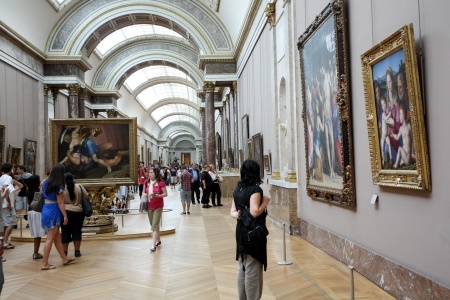

I not long ago obtained an email that is reflective of a range of reviews and issues I have viewed on our social media web pages and in e-mails. Quite a few artists have puzzled what my thoughts are relating to fine artwork vs. ornamental art, as this artist does in her electronic mail:
1 of the issues I’ve discovered about the work you have shared as “recent sales” is that these parts typically appear to be to be “decorative,” as opposed to “fine art.” When I notice that these definitions may well be exterior of the conversation many artwork specialists have publicly, I marvel if your gallery sells far more of just one form of art than the other. Do your purchasers commonly seek art that boosts the decor of their houses, or do they want artwork that turns into an emotional touch position, as effectively as a visible just one? I think about they do the two, but how many are conscious of the variance, or treatment? Do you see a demographic variation concerning these varieties of buyers/collectors?
JK-Artist
I uncovered this e-mail considerate and sincere, but quite a few of the communiques I acquire on this subject are to some degree combative – “The art you market,” they seem to say, “isn’t fine artwork.”
A quick look at the dictionary gives us these definitions:
Decorative Art
noun
1. artwork that is meant to be handy as well as lovely, as ceramics, furnishings, jewelry, and textiles.
2. Usually, decorative arts. any of the arts, as ceramics or jewellery making, whose is effective are created to be useful.
3. functions of attractive art collectively.
Great Artwork
noun
1. a visible art viewed as to have been developed largely for aesthetic needs and judged for its natural beauty and meaningfulness, precisely, portray, sculpture, drawing, watercolor, graphics, and architecture.
Appears quite easy – if a piece of art has some functionality, it’s viewed as ornamental. If it’s purely aesthetic, it’s fine art. By these definitions most of what I offer fits the definition of great artwork.
This plainly isn’t how JK is pondering of the variance, nevertheless, and most of the other reviews I see in this regard also aren’t drawing the line primarily based on the dictionary definitions. In its place, quite a few artists take into account art bought for its ornamental houses (its capability to appear very good with a couch, or on a wall of a particular colour, for example) to be of a lesser benefit, although true art is ordered for its intrinsic inventive worth (?) or possibly not purchased at all since it is way too “fine.”

I may well not be understanding the difference correctly, but I get the sense a ton of artists come to feel their possess function is complex or complicated, and is consequently a lot less probably to be appreciated by the basic public and sell. They feel their art is as a result “fine art.” Art that appeals to a wide audience and sells swiftly is “decorative.” In yet another version of the discussion, the high-quality art is the work that is likely to stop up in a museum a person working day, but not necessarily in buyers’ dwelling rooms.
So what does all of this imply to me as a gallery owner? How significantly time do I spend thinking about the “fine” nature of an artist’s work right before agreeing to stand for the artist? Do I really feel responsible about selling “decorative art?”
When the issue and situation is difficult, my answer is straightforward: I really do not expend a one assumed on this issue.
I truly feel that fine artwork is in the eye of the beholder. I look for artwork that pursuits and excites me and that will bring an attention-grabbing dimension to our gallery. As the e-mail higher than states, I’m seeking for artwork that has an “emotional touch point.” Which is my great artwork. A visitor to the gallery could possibly feel the exact same and come to be inspired to acquire the piece, or they may not experience any link and walk appropriate out the door.
To the email’s position that some customers might be more inspired by the way a piece will fit into their decor than the way the do the job resonates with them, this does materialize, certainly, but in my working experience this occurs in a minority of product sales. It is pretty much generally the situation the our consumers say, “I love this piece,” and then “where will we location it?”
Are there periods when a client comes in and suggests, “I’m hunting for artwork for a unique space”? Absolutely sure. Are there moments when a shopper buys a piece because it will match a sofa? Certainly. Do I refuse to promote art to these purchasers? No.
My hope is that above time I can teach my collectors to have a further appreciation for the art and a improved knowledge of what it is that draws them to a specific piece. Art gathering is a approach – style is refined in excess of time.
I leave the worry about the prolonged-phrase artistic benefit of the artwork to the museum curators. At the possibility of sounding a minor crass, I’m in the organization of providing artwork.
Far more importantly, I’m not at all absolutely sure that it would be powerful for me to try to establish what’s good artwork and what is not. I’ve expended a large amount time studying artwork heritage, and in my looking at it looks that it’s quite tough for any one to know which art is likely to be good on a historic scale in the instant the art is becoming made and on the marketplace. There had been heated battles in excess of no matter whether the impressionists have been generating good artwork. The summary expressionists were derided as hacks.
Once more, the query is past my shell out grade.
The great information in all of this is that no make a difference what you are generating, there are prospective buyers out there to whom your get the job done is fantastic art. Let’s cease stressing about no matter if art is wonderful or not, and get out there and find them!
What Do You Think About Good Artwork vs. Decorative Artwork?
Do you make a distinction involving wonderful art and “decorative” art? Do you come to feel galleries ought to aim on showing extra great art? Do you take into consideration your get the job done to be good art? How a great deal do you believe about the historic importance of your get the job done? Be sure to share your ideas, knowledge, and thoughts in the reviews down below.

